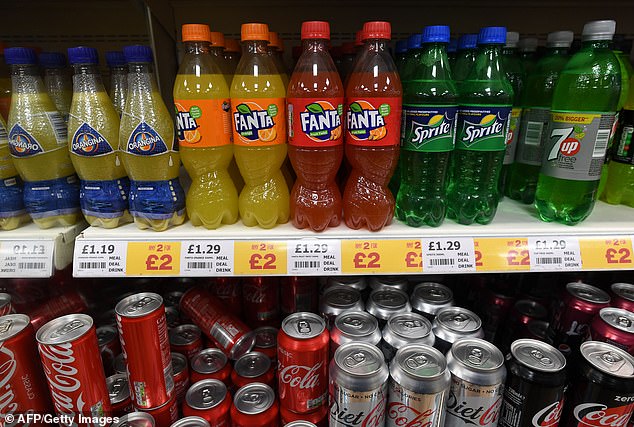Scientists have long known that those who regularly guzzle fizzy drinks, like Cola and Sprite, are more likely to suffer a host of heart and dental problems, compared to those who opt for water instead.
But now an investigation has revealed the worst offenders: with some cans containing five times the amount of sugar and four times the calories than others.
The unhealthiest of the bunch is Coca Cola Cherry, containing nearly three teaspoons of sugar and nearly the same calories as three chocolate chip cookies.
However, if your pop of choice is old-fashioned American soda, you might not be as prone to the negative health consequences.
One 330ml can of Barr American Cream Soda contains less than two teaspoons of sugar and less than 10 calories.
Lemonade fans are in luck too — one can of R-Whites Premium Lemonade contains two teaspoons of the sweet stuff and fewer calories than an apple.
NHS guidelines recommend consuming no more than six teaspoons of ‘free’ sugars per day — which means sugars that are in cakes, sweets, chocolates and fizzy drinks.
Just behind the cherry version, the original was also found to have a high amount of sugar, a teaspoon more than a Mars Bar, but about the same calories as the cherry version.

Over 3.2 billion cans of the carbonated beverages were sold in the UK in 2023
The analysis has also highlighted how energy drinks vary by sugar content. For instance, you’ll get slightly more sugar in Red Bull for the same amount of regular Coke, and roughly the same calories.
While a large can of Monster doesn’t differ much in terms of sugar, it will set you back 235 calories — about 100 more than a Red Bull, although it is double the size.
In better news, a 380ml bottle of Lucozade contains roughly half the sugar of the Coke cans but roughly the same calories.
Highly caffeinated energy drinks have previously been linked to five deaths and one non-fatal heart attack according to the US Food and Drug Administration.
Over 3.2 billion cans of the carbonated beverages were sold in the UK in 2023, and experts have long warned that the ’empty’ calories they contain are to blame for thousands’ expanding waistlines.
A 2010 study by experts at Harvard University found that people who drink one can or more per day of sugar-sweetened drinks have a 26 per cent increased risk of developing type 2 diabetes.
The condition can develop when the body becomes less effective at storing and managing blood sugar, which is the job of the hormone insulin.

Almost 4.3 million people were living with diabetes in 2021/22, according to the latest figures for the UK. And another 850,000 people have diabetes and are completely unaware of it, which is worrying because untreated type 2 diabetes can lead to complications including heart disease and strokes
‘It gets to the point where the cells in your body have had so much insulin coming at them that they become disordered and can’t cope anymore,’ nutritional therapist Jeannette Hyde told the Telegraph.
Emerging evidence suggests drinking lots of sugary drinks may also increase risk of heart disease because they are thought to raise triglycerides — a type of fat that can thicken the arteries supplying the heart.
High sugar intake, particularly from sugary beverages, has also been show to lead to fat accumulation in the liver, non-alcoholic fatty liver disease and — potentially, according to some research — a higher risk of liver cancer.
Experts have debated whether swapping your favourite sugary drink for the sugar free alternative would be beneficial.
‘They’re a great first step for somebody who wants to reduce their sugar intake,’ Beth Bradshaw, a public health nutritionist, told the Telegraph.
Recent studies have found that the artificial sweeteners used in soft drinks, such as aspartame and sucralose, may also prompt insulin resistance over time.
Writing for MailOnline Professor Tim Spector, the brains behind the diet app ZOE, said: ‘Man-made sweeteners are not found in nature, most came from the petrochemical industry and they are not inert, harmless substances.’
This article was originally published by a www.dailymail.co.uk . Read the Original article here. .


